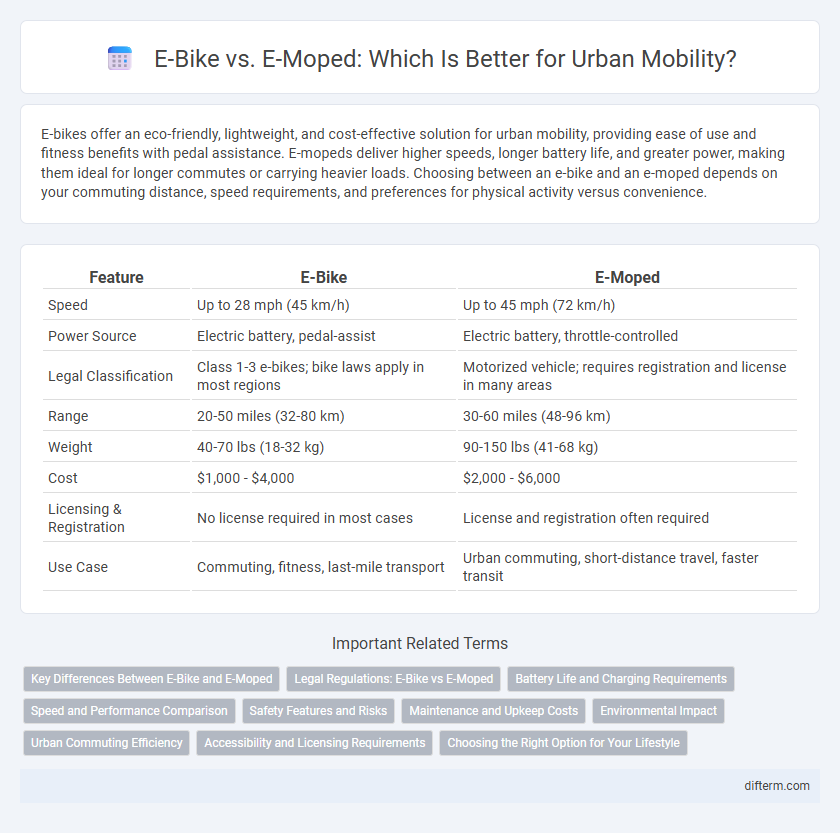E-bikes offer an eco-friendly, lightweight, and cost-effective solution for urban mobility, providing ease of use and fitness benefits with pedal assistance. E-mopeds deliver higher speeds, longer battery life, and greater power, making them ideal for longer commutes or carrying heavier loads. Choosing between an e-bike and an e-moped depends on your commuting distance, speed requirements, and preferences for physical activity versus convenience.
Table of Comparison
| Feature | E-Bike | E-Moped |
|---|---|---|
| Speed | Up to 28 mph (45 km/h) | Up to 45 mph (72 km/h) |
| Power Source | Electric battery, pedal-assist | Electric battery, throttle-controlled |
| Legal Classification | Class 1-3 e-bikes; bike laws apply in most regions | Motorized vehicle; requires registration and license in many areas |
| Range | 20-50 miles (32-80 km) | 30-60 miles (48-96 km) |
| Weight | 40-70 lbs (18-32 kg) | 90-150 lbs (41-68 kg) |
| Cost | $1,000 - $4,000 | $2,000 - $6,000 |
| Licensing & Registration | No license required in most cases | License and registration often required |
| Use Case | Commuting, fitness, last-mile transport | Urban commuting, short-distance travel, faster transit |
Key Differences Between E-Bike and E-Moped
E-bikes typically feature pedal assist systems with motor power up to 750 watts, allowing speeds up to 28 mph, while e-mopeds often have throttle-only controls, higher motor power exceeding 1000 watts, and can reach speeds up to 45 mph. Regulatory distinctions include e-bikes being classified as bicycles in many regions with minimal licensing requirements, whereas e-mopeds are often subject to moped or motorcycle laws, requiring registration, insurance, and a driver's license. Battery capacity and weight also differ, with e-mopeds generally possessing larger batteries for extended range but greater overall weight compared to lighter, more compact e-bikes optimized for urban commuting.
Legal Regulations: E-Bike vs E-Moped
E-bikes are generally classified as bicycles with electric assistance limited to 25 km/h and 250 watts, requiring no license or registration in many regions. E-mopeds often exceed these limits, reaching speeds up to 45 km/h, and require vehicle registration, insurance, and a valid driver's license. Legal regulations for e-mopeds are stricter to ensure safety on public roads, reflecting their closer similarity to motorized vehicles compared to e-bikes.
Battery Life and Charging Requirements
E-bikes typically feature batteries with capacities ranging from 300 to 700 watt-hours, offering a range of 20 to 60 miles per charge and requiring 3 to 6 hours for a full recharge. E-mopeds use larger batteries, often between 1000 and 3000 watt-hours, providing extended ranges of 40 to 100 miles and necessitating longer charging times of 4 to 8 hours, sometimes supported by fast-charging options. Battery management systems in both vehicle types optimize performance and lifespan, but the increased power demands of e-mopeds lead to greater energy consumption and longer downtime between uses.
Speed and Performance Comparison
E-bikes typically reach speeds of 20-28 mph, making them suitable for urban commutes with moderate acceleration and pedal-assist performance, whereas e-mopeds can achieve speeds up to 45 mph due to more powerful motors and higher torque, offering faster acceleration and better hill-climbing capabilities. Battery capacity and motor power in e-mopeds usually exceed those in e-bikes, resulting in longer range and sustained high-speed travel. Regulatory speed limits often impact e-bike and e-moped performance classifications, influencing their design and usage in various regions.
Safety Features and Risks
E-bikes offer enhanced safety features such as pedal-assist technology that limits speed and reduces accident risks, while e-mopeds typically include sturdier frames and more robust braking systems for higher velocity control. E-mopeds, capable of reaching faster speeds, present greater collision hazards and require more protective gear compared to e-bikes, which are generally safer for urban commuting. Both vehicles incorporate lights and reflectors, but e-mopeds often mandate helmet laws and insurance, reflecting their increased operational risks.
Maintenance and Upkeep Costs
E-bikes generally have lower maintenance and upkeep costs compared to e-mopeds due to simpler mechanical components and fewer regulatory requirements. Battery replacement and brake servicing are common but inexpensive for e-bikes, while e-mopeds require more frequent engine maintenance, insurance, and registration fees, increasing overall expenses. The cost-effectiveness of e-bikes makes them ideal for urban commuters seeking affordable and low-maintenance electric mobility options.
Environmental Impact
E-bikes produce significantly lower carbon emissions than e-mopeds, with average CO2 outputs approximately 22 grams per kilometer compared to 50-80 grams for e-mopeds. Electric bikes rely on human power, reducing battery and energy consumption, while e-mopeds use larger batteries and require more electricity, increasing their environmental footprint. Lifecycle assessments reveal e-bikes have a smaller impact on air quality and resource depletion, making them a more sustainable option for urban mobility.
Urban Commuting Efficiency
E-bikes offer superior urban commuting efficiency with faster acceleration, easier maneuverability, and lower energy consumption compared to e-mopeds. Their lightweight design allows riders to navigate congested city streets and bike lanes, reducing travel times and parking challenges. E-mopeds, while providing higher speed potential, often face restrictions in dense urban areas that limit their overall commuting advantage.
Accessibility and Licensing Requirements
E-bikes offer greater accessibility due to minimal licensing requirements and ease of use, often classified similarly to traditional bicycles. E-mopeds typically require a driver's license, registration, and insurance, limiting access for some riders, especially younger or less experienced individuals. The simpler regulatory framework for e-bikes promotes urban mobility and reduces barriers to entry compared to e-mopeds.
Choosing the Right Option for Your Lifestyle
E-bikes offer a fitness-friendly, eco-conscious mode of transport ideal for urban commuting and moderate distances, while e-mopeds provide higher speeds and greater range suited for longer trips and less physically intensive travel. Consider your daily travel distance, road environment, and legal requirements such as licensing and helmet laws to determine the best fit for your needs. Battery life, top speed, and storage options also play critical roles in tailoring your mobility choice to your lifestyle demands.
e-bike vs e-moped Infographic

 difterm.com
difterm.com